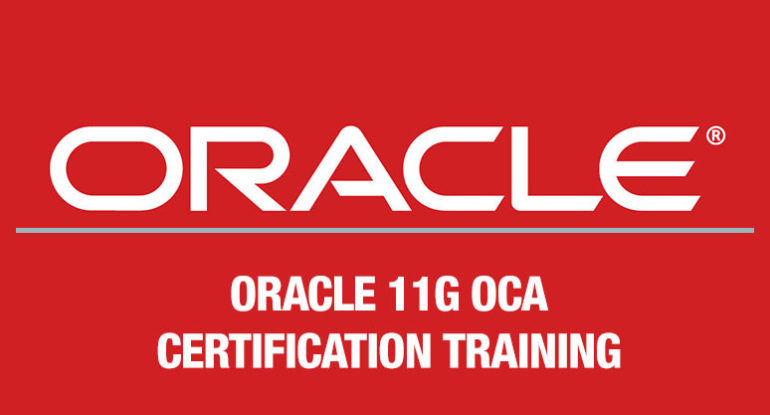- Home
- Database
- Networking
- Programming
- Online Courses
- Mobile Application
- Web App Developments
- Cryptocurrency Wallets and Mining Coins
- Q# Programming
- BlockChain Application Development
- Java Servlet Programming
- Java Training with Spring
- Developing Images with Docker
- C++ Training
- Python RPA Programming
- Excel VBA Training
- Ruby on Rails Training
- C# Training Course
- Testing
- Automation Test Engineer
- Penetration Testing
- Cucumber BDD
- Selenium Web Test Training Java
- Selenium Test Automation with PHP
- Selenium Test Automation with C# .NET and NUnit
- Android Appium Test Automation
- Online Performance Testing
- Python Automation Testing with Selenium and BDD
- Automation Test Architect
- Automation Test Analyst
- SpecFlow Automation Testing
- Contact
- About Us
Oracle 11g OCA Certification Training Course
Course Overview
Oracle 11g Database certified will broaden your knowledge and skills by exposing you to a variety of important database features, functions and tasks. Oracle Database certification will teach you how to perform complex, hands-on activities through labs, study and practice. Oracle certification exams will validate your capabilities using real-world, scenario-based questions that will assess and challenge your ability to think and perform. Our course will not only teach you the skills to make you a oracle database specialist, but also will prepare you for the Oracle Certified Associate level exams.
COURSE START DATES
| Start Date | Time | Days | Duration | Location |
|---|---|---|---|---|
| 05/05/2020 | 18.00-21.00 | Tue/Thu | 10 Classes | Brentford |
| 25/08/2020 | 18.00-21.00 | Tue/Thu | 10 Classes | Brentford |
| 15/12/2020 | 18.00-21.00 | Tue/Thu | 10 Classes | Brentford |
| 23/03/2021 | 18.00-21.00 | Tue/Thu | 10 Classes | Brentford |
Prerequisites
Target Audience
Course Content
Oracle Database/ SQL Expert: Exam 1Z0-147
- Relational Database Systems
- Testing SQL
- SQL Developer and SQL Plus
- Testing the Database and Schema
- Basic Select Statements
- Selecting Columns and Using Arithmetic Operators
- Operator Precedence
- Concatenation Operator
- Displaying the Table Structure
- Implementing the Where Clause
- Comparison Operators
- Logical Operators
- Rules of Precedence
- Substitution Variables
- Types of Single Row Functions
- Working with Dates
- Types of Group Functions
- Creating Groups of Data
- Multi Column Grouping
- Natural Joins
- Nonequijoins and Outer Joins
- Cartesian Joins
- Single Row Subqueries
- Multiple Row Subqueries
- Null Values
- Union and Union All Operators
- Intersect and Minus Operators
- Select Statements and the Order By Clause
Oracle OCA Exam 1Z0-152
- Architectural Components of the Oracle Database
- Memory Structures
- Server and Background Processes
- Logical and Physical Storage Structures
- Database Administrator Tasks and Tools
- Planning a Oracle Database Installation
- Using Optimal Flexible Architecture
- Installing the Oracle Software using OUI
- Planning for Database Creation
- Configuring the Listener
- Creating a Database
- Starting and Stopping the Oracle Database
- Using the Oracle Enterprise Manager
- Access a Database with SQL*Plus
- Modify Database Initialization Parameters
- Database Startup
- Database Shutdown
- Viewing the Alert Log and Dynamic Performance Views
- Creating and Configuring Additional Listeners
- Creating Oracle Net Service Aliases
- When to Use Shared and Dedicated Servers
- Describe Table Row Data and Define Tablespaces
- Creating and Managing Tablespaces
- Automatic Storage Management
- Create and Manage User Accounts
- Grant and Revoke Privileges
- Create and Manage Roles
- Create and Manage Profiles
- Defining Schema Objects and Data Types
- Creating and Modifying Tables
- Defining Constraints
- Viewing Columns and Contents of a Table
- Creating Indexes
- Creating Views
- Creating Sequences
- Using Temporary Tables
- Managing data Using SQL
- Identifying and Administering PL/SQL Objects
- Monitoring and Resolving Locking Conflicts
- Implementing Undo Data
- Working with Undo Data
- DBA Security and Privileges
- Enabling Auditing
- Audit Options and Information
- Fine Grained Auditing
- Auditing the DBA and Maintaining the Audit Trail
- Managing Optimizer Statistics
- Managing Automatic Workload Repository
- Using the Automatic Database Diagnostic Monitor
- Setting Alerts and Thresholds
- Performance Monitoring with the Enterprise Manager
- Using Automatic Memory Management
- Viewing Performance Related Dynamic Views
- Troubleshooting invalid and Unusable Objects
- Types of Database Failure
- Checkpoints| Redo Log Files| and Archive Log Files
- Instance Recovery
- Configuring for Recoverability
- Configuring Archive Log Mode
- Database Backups
- Backup Solutions Overview
- Configuring Backup Settings
- Scheduling Backups
- Backing up Control Files to a Trace File
- Managing Backups and the Flash Recovery Area
- Using the RMAN Command Line
- Recovering From a Lost Control File
- Recovering Redo Log Files
- Recovering Non Critical and Critical Data Files
- Using the Data Recovery Advisor
- Moving Data and Creating Directory Objects
- Loading Data with the SQL Loader
- Creating and Reading External Tables
- Using Oracle Data Pump Export and Import
- Data Pump Performance and Monitoring
- Using the Enterprise Manager Support Workbench
- Metalink Integration and Managing Patches
- Monitoring index partition usage
- Rebuilding unusable indexes




Reviews
There are no reviews yet.